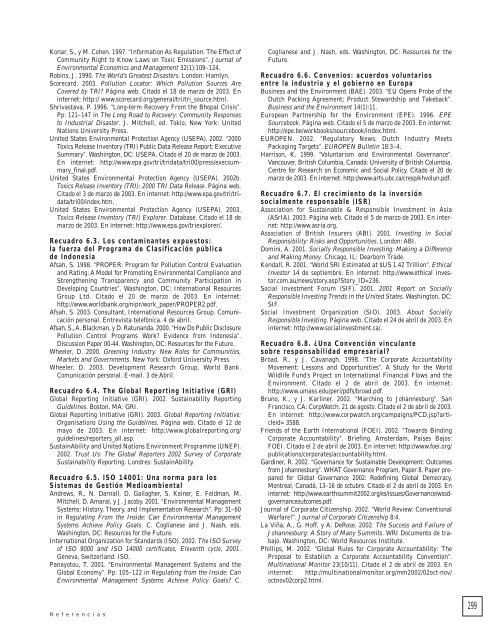PAGINAS I A XII.qxd - World Resources Institute
PAGINAS I A XII.qxd - World Resources Institute
PAGINAS I A XII.qxd - World Resources Institute
- No tags were found...
Create successful ePaper yourself
Turn your PDF publications into a flip-book with our unique Google optimized e-Paper software.
Konar, S., y M. Cohen. 1997. “Information As Regulation: The Effect ofCommunity Right to Know Laws on Toxic Emissions”. Journal ofEnvironmental Economics and Management 32(1):109–124.Robins, J. 1990. The <strong>World</strong>’s Greatest Disasters. London: Hamlyn.Scorecard. 2003. Pollution Locator: Which Pollution Sources AreCovered by TRI? Página web. Citado el 18 de marzo de 2003. Eninternet: http:// www.scorecard.org/general/tri/tri_source.html.Shrivastava, P. 1996. “Long-term Recovery From the Bhopal Crisis”.Pp: 121–147 in The Long Road to Recovery: Community Responsesto Industrial Disaster. J. Mitchell, ed. Tokio; New York: UnitedNations University Press.United States Environmental Protection Agency (USEPA). 2002. “2000Toxics Release Inventory (TRI) Public Data Release Report: ExecutiveSummary”. Washington, DC: USEPA. Citado el 20 de marzo de 2003.En internet: http://www.epa.gov/tri/tridata/tri00/press/execsummary_final.pdf.United States Environmental Protection Agency (USEPA). 2002b.Toxics Release Inventory (TRI): 2000 TRI Data Release. Página web.Citado el 3 de marzo de 2003. En internet: http://www.epa.gov/tri/tridata/tri00/index.htm.United States Environmental Protection Agency (USEPA). 2003.Toxics Release Inventory (TRI) Explorer. Database. Citado el 18 demarzo de 2003. En internet: http://www.epa.gov/triexplorer/.Recuadro 6.3. Los contaminantes expuestos:la fuerza del Programa de Clasificación públicade IndonesiaAfsah, S. 1998. “PROPER: Program for Pollution Control Evaluationand Rating: A Model for Promoting Environmental Compliance andStrengthening Transparency and Community Participation inDeveloping Countries”. Washington, DC: International <strong>Resources</strong>Group Ltd. Citado el 20 de marzo de 2003. En internet:http://www.worldbank.org/nipr/work_paper/PROPER2.pdf.Afsah, S. 2003. Consultant, International <strong>Resources</strong> Group. Comunicaciónpersonal. Entrevista telefónica. 4 de abril.Afsah, S., A. Blackman, y D. Ratunanda. 2000. “How Do Public DisclosurePollution Control Programs Work? Evidence from Indonesia”.Discussion Paper 00-44. Washington, DC: <strong>Resources</strong> for the Future.Wheeler, D. 2000. Greening Industry: New Roles for Communities,Markets and Governments. New York: Oxford University Press.Wheeler, D. 2003. Development Research Group, <strong>World</strong> Bank.Comunicación personal. E-mail. 3 de Abril.Recuadro 6.4. The Global Reporting Initiative (GRI)Global Reporting Initiative (GRI). 2002. Sustainability ReportingGuidelines. Boston, MA: GRI.Global Reporting Initiative (GRI). 2003. Global Reporting Initiative:Organisations Using the Guidelines. Página web. Citado el 12 demayo de 2003. En internet: http://www.globalreporting.org/guidelines/reporters_all.asp.SustainAbility and United Nations Environment Programme (UNEP).2002. Trust Us: The Global Reporters 2002 Survey of CorporateSustainability Reporting. Londres: SustainAbility.Recuadro 6.5. ISO 14001: Una norma para losSistemas de Gestión MedioambientalAndrews, R., N. Darnall, D. Gallagher, S. Keiner, E. Feldman, M.Mitchell, D. Amaral, y J. Jacoby. 2001. “Environmental ManagementSystems: History, Theory, and Implementation Research”. Pp: 31–60in Regulating From the Inside: Can Environmental ManagementSystems Achieve Policy Goals. C. Coglianese and J. Nash, eds.Washington, DC: <strong>Resources</strong> for the Future.International Organization for Standards (ISO). 2002. The ISO Surveyof ISO 9000 and ISO 14000 certificates, Eleventh cycle, 2001.Geneva, Switzerland: ISO.Panayotou, T. 2001. “Environmental Management Systems and theGlobal Economy”. Pp: 105–122 in Regulating from the Inside: CanEnvironmental Management Systems Achieve Policy Goals? C.Coglianese and J. Nash, eds. Washington, DC: <strong>Resources</strong> for theFuture.Recuadro 6.6. Convenios: acuerdos voluntariosentre la industria y el gobierno en EuropaBusiness and the Environment (BAE). 2003. “EU Opens Probe of theDutch Packing Agreement; Product Stewardship and Takeback”.Business and the Environment 14(1):11.European Partnership for the Environment (EPE). 1996. EPESourcebook. Página web. Citado el 5 de marzo de 2003. En internet:http://epe.be/workbooks/sourcebook/index.html.EUROPEN. 2002. “Regulatory News: Dutch Industry MeetsPackaging Targets”. EUROPEN Bulletin 18:3–4.Harrison, K. 1999. “Voluntarism and Environmental Governance”.Vancouver, British Columbia, Canadá: University of British Columbia,Centre for Research on Economic and Social Policy. Citado el 20 demarzo de 2003. En internet: http://www.arts.ubc.ca/cresp/khvolun.pdf.Recuadro 6.7. El crecimiento de la inversiónsocialmente responsable (ISR)Association for Sustainable & Responsible Investment in Asia(ASrIA). 2003. Página web. Citado el 5 de marzo de 2003. En internet:http://www.asria.org.Association of British Insurers (ABI). 2001. Investing in SocialResponsibility: Risks and Opportunities. London: ABI.Domini, A. 2001. Socially Responsible Investing: Making a Differenceand Making Money. Chicago, IL: Dearborn Trade.Kendall, R. 2001. “<strong>World</strong> SRI Estimated at $US 1.42 Trillion”. EthicalInvestor 14 de septiembre. En internet: http://www.ethical investor.com.au/news/story.asp?Story_ID=236.Social Investment Forum (SIF). 2001. 2001 Report on SociallyResponsible Investing Trends in the United States. Washington, DC:SIF.Social Investment Organization (SIO). 2003. About SociallyResponsible Investing. Página web. Citado el 24 de abril de 2003. Eninternet: http://www.socialinvestment.ca/.Recuadro 6.8. ¿Una Convención vinculantesobre responsabilidad empresarial?Broad, R., y J. Cavanagh. 1998. “The Corporate AccountabilityMovement: Lessons and Opportunities”. A Study for the <strong>World</strong>Wildlife Fund’s Project on International Financial Flows and theEnvironment. Citado el 2 de abril de 2003. En internet:http://www.umass.edu/peri/pdfs/broad.pdf.Bruno, K., y J. Karliner. 2002. “Marching to Johannesburg”. SanFrancisco, CA: CorpWatch. 21 de agosto. Citado el 2 de abril de 2003.En internet: http://www.corpwatch.org/campaigns/PCD.jsp?articleid=3588.Friends of the Earth International (FOEI). 2002. “Towards BindingCorporate Accountability”. Briefing. Amsterdam, Países Bajos:FOEI. Citado el 2 de abril de 2003. En internet: http://www.foei.org/publications/corporates/accountability.html.Gardiner, R. 2002. “Governance for Sustainable Development: Outcomesfrom Johannesburg”. WHAT Governance Program, Paper 8. Paper preparedfor Global Governance 2002: Redefining Global Democracy,Montreal, Canadá, 13–16 de octubre. Citado el 2 de abril de 2003. Eninternet: http://www.earthsummit2002.org/es/issues/Governance/wssdgovernanceoutcomes.pdf.Journal of Corporate Citizenship. 2002. “<strong>World</strong> Review: ConventionalWarfare?”. Journal of Corporate Citizenship 8:4.La Viña, A., G. Hoff, y A. DeRose. 2002. The Success and Failure ofJohannesburg: A Story of Many Summits. WRI Documento de trabajo.Washington, DC: <strong>World</strong> <strong>Resources</strong> <strong>Institute</strong>.Phillips, M. 2002. “Global Rules for Corporate Accountability: TheProposal to Establish a Corporate Accountability Convention”.Multinational Monitor 23(10/11). Citado el 2 de abril de 2003. Eninternet: http://multinationalmonitor.org/mm2002/02oct-nov/octnov02corp2.html.Referencias299
















